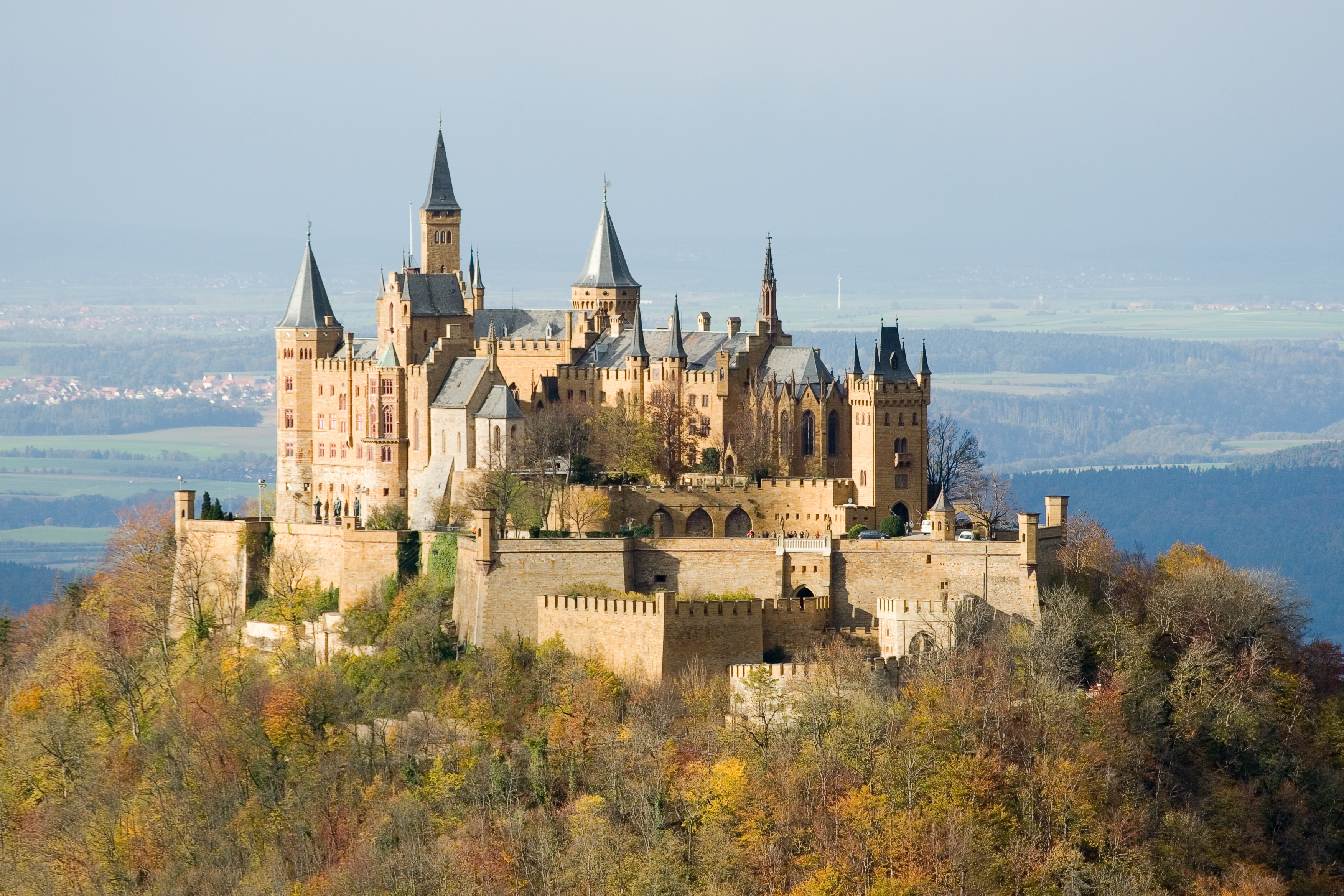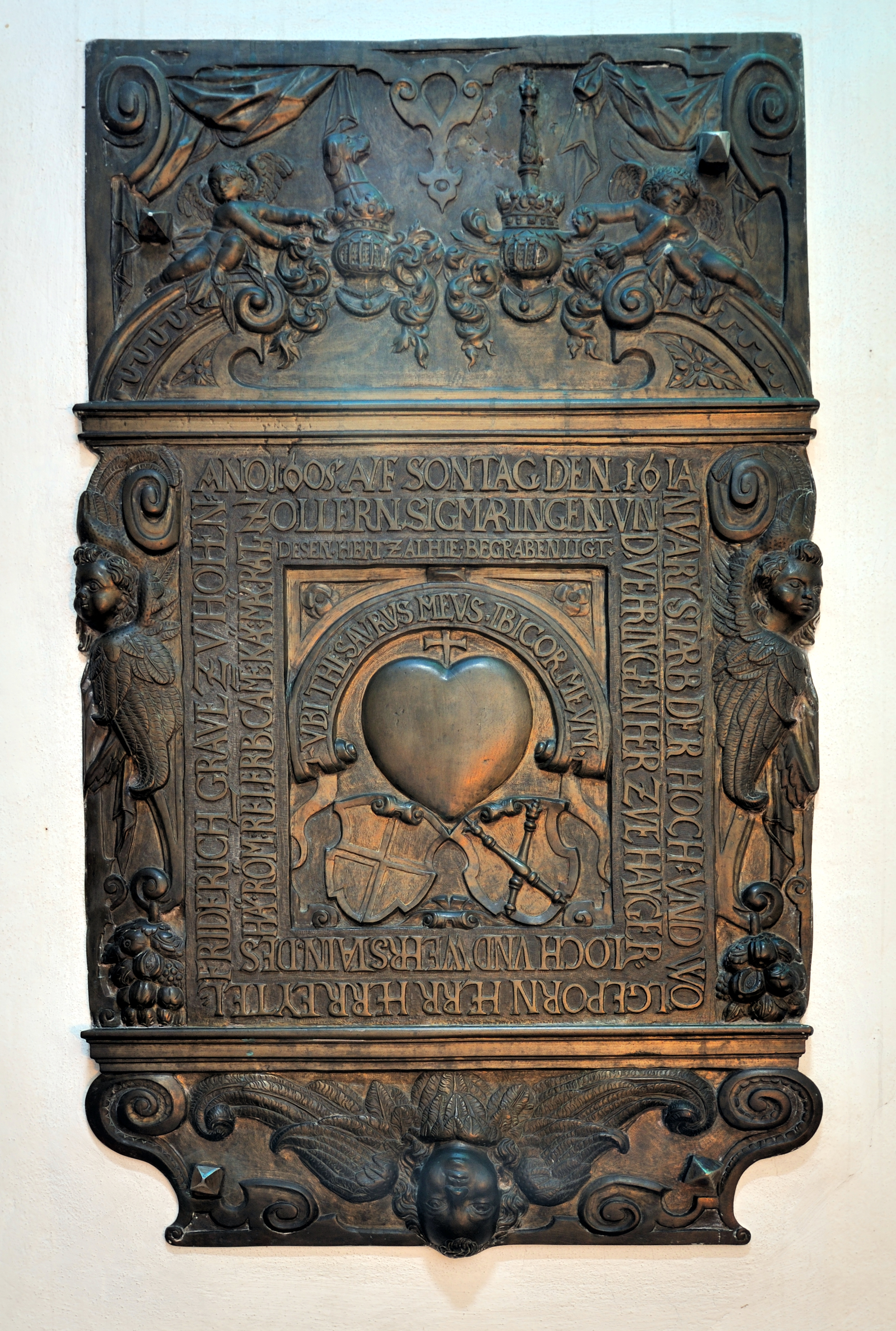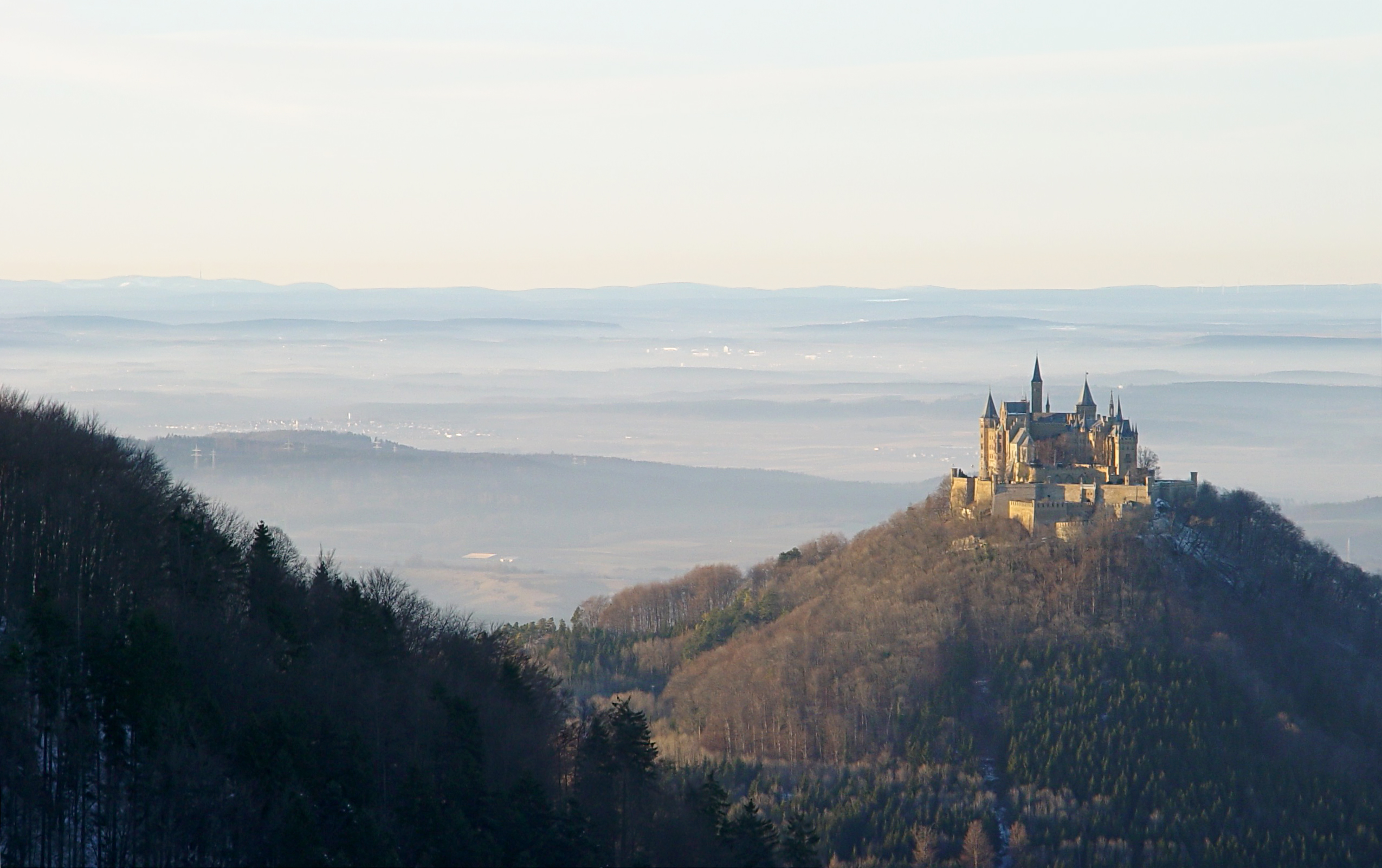|
Johann Christoph, Count Of Hohenzollern-Haigerloch
Johann Christoph, Count of Hohenzollern-Haigerloch (1586 in Haigerloch – 1620 in Haigerloch) was the second Count of Hohenzollern-Haigerloch. Life Johann Christoph was the eldest son of Count Christoph of Hohenzollern-Haigerloch, from his marriage to Katharina (d. after 1608), daughter of Christoph, Baron of Welsperg. Johann Christoph was still a minor when he inherited the County, and his uncles Eitel Friedrich IV of Hohenzollern-Hechingen and Karl II of Hohenzollern-Sigmaringen took up the regency and guardianship. He served in the imperial army and lived mostly in Vienna. In 1608 in Sigmaringen, he married his cousin Marie (1592–1658), a daughter of his erstwhile guardian Count Karl II of Hohenzollern-Sigmaringen. This marriage remained childless. In 1612, he acquired Haag-Schlössle Castle in Haigerloch, where his widow would live after his death. His father had started the construction of the castle church. During Johann Christoph's reign, it was comple ... [...More Info...] [...Related Items...] OR: [Wikipedia] [Google] [Baidu] |
House Of Hohenzollern
The House of Hohenzollern (, ; , ; ) is a formerly royal (and from 1871 to 1918, imperial) German dynasty whose members were variously princes, Prince-elector, electors, kings and emperors of Hohenzollern Castle, Hohenzollern, Margraviate of Brandenburg, Brandenburg, Prussia, the German Empire, and Kingdom of Romania, Romania. The family came from the area around the town of Hechingen in Swabia during the late 11th century and took their name from Hohenzollern Castle. The first ancestors of the Hohenzollerns were mentioned in 1061. The Hohenzollern family split into two branches, the Catholic Church, Catholic Swabian branch and the Protestantism, Protestant Burgraviate of Nuremberg#List of burgraves, Franconian branch,''Genealogisches Handbuch des Adels, Fürstliche Häuser'' XIX. "Haus Hohenzollern". C.A. Starke Verlag, 2011, pp. 30–33. . which ruled the Burgraviate of Nuremberg and later became the Brandenburg-Prussian branch. The Swabian branch ruled the principalities of Hoh ... [...More Info...] [...Related Items...] OR: [Wikipedia] [Google] [Baidu] |
Christoph, Count Of Hohenzollern-Haigerloch
Count Christoph of Hohenzollern-Haigerloch (20 March 1552 in Haigerloch – 21 April 1592, Haigerloch) was the first Count of Hohenzollern-Haigerloch. Life Christoph was the third surviving son of Count Karl I of Hohenzollern (1516–1576) from his marriage to Anna (1512–1579), daughter of Ernst, Margrave of Baden-Durlach. Christoph studied law together with his brother Karl II (1547–1606) studied in Freiburg im Breisgau and Bourges. When Karl I died in 1576, the County of Hohenzollern was divided into Hohenzollern-Hechingen, Hohenzollern-Sigmaringen and Hohenzollern-Haigerloch. Christoph, the youngest son, received the Lordship of Haigerloch, which had been acquired in 1497. It included Enisheim Castle and the towns of Imnau and Stetten. His eldest brother Eitel Friedrich IV received Hechingen, his other brother Karl II received Sigmaringen. Christoph's part had 10000 inhabitants at the time and was substantially smaller than the parts of his brothers. Christ ... [...More Info...] [...Related Items...] OR: [Wikipedia] [Google] [Baidu] |
Haigerloch
Haigerloch () is a town in the north-western part of the Swabian Alb in Germany. Geography Geographical location Haigerloch lies at between 430 and 550 metres elevation in the valley of the Eyach (Neckar), Eyach river, which forms two loops in a steep shelly limestone valley. The town is therefore also called the 'Felsenstädtchen' (rocky/cliffy small town). Neighbouring municipalities Haigerloch's neighbouring municipalities are specified below in clockwise order from the north, and belong to the Zollernalbkreis unless indicated. Starzach ¹, Rangendingen, Grosselfingen, Balingen, Geislingen, Zollernalbkreis, Geislingen, Rosenfeld, Germany, Rosenfeld, Sulz am Neckar ², Empfingen ³ and Horb am Neckar ³. ¹ Landkreis Tübingen, ² Landkreis Rottweil, ³ Landkreis Freudenstadt Districts Haigerloch consists of the following nine districts: * Bad Imnau * Bittelbronn * Gruol * Hart * Haigerloch * Owingen * Stetten * Trillfingen * Weildorf It is located 397 m above mean sea lev ... [...More Info...] [...Related Items...] OR: [Wikipedia] [Google] [Baidu] |
Hohenzollern-Haigerloch
Hohenzollern-Haigerloch was a small county in southwestern Germany. Its rulers belonged to the Swabian branch of the House of Hohenzollern. It became part of the neighboring Hohenzollern-Sigmaringen in 1767. History The more famous younger Franconian branch of the Hohenzollern family became Burgraves of Nuremberg, Margraves of Brandenburg, Kings of Prussia, and finally Emperors of Germany. Unlike their northern relatives, the Swabians remained Catholic. The county of Hohenzollern-Haigerloch was created in 1576, when Karl I of Hohenzollern died and his lands were divided between his three sons: * Eitel Friedrich IV of Hohenzollern-Hechingen (1545–1605) * Charles II of Hohenzollern-Sigmaringen (1547–1606) * Christoph of Hohenzollern-Haigerloch (1552–1592) All three territories were located in south-western Germany and were fiefs of the Holy Roman Empire. The area is now part of the German Land of Baden-Württemberg. Hechingen, Sigmaringen, and Haigerloch were the c ... [...More Info...] [...Related Items...] OR: [Wikipedia] [Google] [Baidu] |
Eitel Friedrich IV, Count Of Hohenzollern
Count Eitel Friedrich IV of Hohenzollern (7 September 1545 in Sigmaringen – 16 January 1605 in Hechingen) was the founder and first Count of the line Hohenzollern-Hechingen as Eitel Friedrich I. Early life Eitel Friedrich was the eldest surviving son of Count Karl I of Hohenzollern (1516–1576) from his marriage to Princess Anna of Baden-Durlach (1512–1579), daughter of the Margrave Ernst of Baden-Durlach. Biography After his father's death in 1576, Hohenzollern was divided. Eitel Friedrich became the founder of the Hohenzollern-Hechingen line; his brother Karl founded the Hohenzollern-Sigmaringen line, and his brother Christoph founded the Hohenzollern-Haigerloch line. Hohenzollern-Hechingen included the original County of Zollern, with the town of Hechingen and monasteries at Rangendingen, St. Luzen and Stetten. Eitel Friedrich reorganized the administration of the county, which his predecessors had neglected. He issued strict hunting and forestry regula ... [...More Info...] [...Related Items...] OR: [Wikipedia] [Google] [Baidu] |
Karl II, Count Of Hohenzollern-Sigmaringen
Charles II, Count of Hohenzollern-Sigmaringen (; 1547 – 8 April 1606) became Count of Hohenzollern-Sigmaringen in 1576 and remained so until his death. He was the fifth but second surviving son of Charles I, Count of Hohenzollern, and Anna, daughter of Ernest, Margrave of Baden-Durlach. Life Initially, he was educated in Vienna, and later in Freiburg im Breisgau jointly with his older brother Eitel Friedrich. Later, he assisted to the Aulic Council in Vienna, where his father served as president; there, he gained the trust and friendship of Ferdinand II, Archduke of Further Austria, (son of Holy Roman Emperor Ferdinand I) and went into his service to Tyrol, being able to established good connections with the Holy Roman Empire, which was seen in 1570 when he was appointed Supreme Captain and Governor in Alsace. Two years later, Charles II took over the guardianship of Count Jakob of Geroldseck. Under the rule of his father Charles I the possessions of the county of Zollern ... [...More Info...] [...Related Items...] OR: [Wikipedia] [Google] [Baidu] |
Vienna
Vienna ( ; ; ) is the capital city, capital, List of largest cities in Austria, most populous city, and one of Federal states of Austria, nine federal states of Austria. It is Austria's primate city, with just over two million inhabitants. Its larger metropolitan area has a population of nearly 2.9 million, representing nearly one-third of the country's population. Vienna is the Culture of Austria, cultural, Economy of Austria, economic, and Politics of Austria, political center of the country, the List of cities in the European Union by population within city limits, fifth-largest city by population in the European Union, and the most-populous of the List of cities and towns on the river Danube, cities on the river Danube. The city lies on the eastern edge of the Vienna Woods (''Wienerwald''), the northeasternmost foothills of the Alps, that separate Vienna from the more western parts of Austria, at the transition to the Pannonian Basin. It sits on the Danube, and is ... [...More Info...] [...Related Items...] OR: [Wikipedia] [Google] [Baidu] |
Sigmaringen
Sigmaringen ( Swabian: ''Semmerenga'') is a town in southern Germany, in the state of Baden-Württemberg. Situated on the upper Danube, it is the capital of the Sigmaringen district. Sigmaringen is renowned for its castle, Schloss Sigmaringen, which was the seat of the principality of Hohenzollern-Sigmaringen until 1850 and is still owned by the Hohenzollern family. Geography Surrounded by wooded hills Sigmaringen lies in the Danube valley, south of the Swabian Alps and around 40 km north of Lake Constance. The surrounding towns are Winterlingen (in the district of Zollernalb) and Veringenstadt in the north, Bingen, Sigmaringendorf, and Scheer in the east, Mengen, Krauchenwies, Inzigkofen, and Meßkirch in the south, and Leibertingen, Beuron, and Stetten am kalten Markt in the west. The town is made up of the following districts: Sigmaringen town center, Gutenstein, Jungnau, Laiz, Oberschmeien, and Unterschmeien. Climate Sigmaringen's climate is classified ... [...More Info...] [...Related Items...] OR: [Wikipedia] [Google] [Baidu] |
Thirty Years' War
The Thirty Years' War, fought primarily in Central Europe between 1618 and 1648, was one of the most destructive conflicts in History of Europe, European history. An estimated 4.5 to 8 million soldiers and civilians died from battle, famine, or disease, while parts of Germany reported population declines of over 50%. Related conflicts include the Eighty Years' War, the War of the Mantuan Succession, the Franco-Spanish War (1635–1659), Franco-Spanish War, the Torstenson War, the Dutch-Portuguese War, and the Portuguese Restoration War. The war had its origins in the 16th-century Reformation, which led to religious conflict within the Holy Roman Empire. The 1555 Peace of Augsburg attempted to resolve this by dividing the Empire into Catholic and Lutheran states, but the settlement was destabilised by the subsequent expansion of Protestantism beyond these boundaries. Combined with differences over the limits of imperial authority, religion was thus an important factor in star ... [...More Info...] [...Related Items...] OR: [Wikipedia] [Google] [Baidu] |
Hohenzollern Castle
Hohenzollern Castle ( ) is the ancestral seat of the imperial House of Hohenzollern. The third of three hilltop castle, hilltop castles built on the site, it is located atop Hohenzollern (mountain), Mount Hohenzollern, above and south of Hechingen, on the edge of the Swabian Jura of central Baden-Württemberg, Germany. The name derives from :de:Söller, Söller (terrace) from Latin ''solarium.'' The first castle on the mountain was constructed in the early 11th century. Over the years the House of Hohenzollern split several times, but the castle remained in the House of Hohenzollern#Swabian senior branch, Swabian branch, the dynastic seniors of the House of Hohenzollern#Franconian branch, Franconian-Brandenburgian cadet branch that later acquired its own imperial throne. This castle was completely destroyed in 1423 after a ten-month siege by the Free imperial city, free imperial cities of Swabia. The second castle, a larger and sturdier structure, was constructed from 1454 to 1 ... [...More Info...] [...Related Items...] OR: [Wikipedia] [Google] [Baidu] |
Karl, Count Of Hohenzollern-Haigerloch
Karl, Count of Hohenzollern-Haigerloch (1588 in Haigerloch – 9 March 1634 in Überlingen) was the third Count of Hohenzollern-Haigerloch. Life Karl was the second son of Count Christoph of Hohenzollern-Haigerloch from his marriage to Katharina (d. after 1608), the daughter of Baron Christoph of Welsperg. After his father's early death, he was raised by his uncles Eitel Friedrich IV of Hohenzollern-Hechingen and Karl II of Hohenzollern-Sigmaringen. After completing his education, he initially pursued a military career. in 1602, Karl succeeded his brother Johann Christoph as Count of Hohenzollern-Haigerloch. He married on 25 March 1618 in Haigerloch to Countess Rosamunde of Ortenburg (d. 1636). This marriage remained childless. In January 1633, at the height of the Thirty Years' War, the Swedish army approached Haigerloch and Karl fled with an entourage of 21 people to Hohenzollern Castle. The Swedish army soon occupied Hohenzollern Castle. Count Karl was grante ... [...More Info...] [...Related Items...] OR: [Wikipedia] [Google] [Baidu] |
Counts Of Hohenzollern-Haigerloch
Count (feminine: countess) is a historical title of nobility in certain European countries, varying in relative status, generally of middling rank in the hierarchy of nobility. Pine, L. G. ''Titles: How the King Became His Majesty''. New York: Barnes & Noble, 1992. p. 73. . Especially in earlier medieval periods the term often implied not only a certain status, but also that the ''count'' had specific responsibilities or offices. The etymologically related English term "county" denoted the territories associated with some countships, but not all. The title of ''count'' is typically not used in England or English-speaking countries, and the term ''earl'' is used instead. A female holder of the title is still referred to as a ''countess'', however. Origin of the term The word ''count'' came into English from the French ', itself from Latin '—in its accusative form ''comitem''. It meant "companion" or "attendant", and as a title it indicated that someone was delegated to rep ... [...More Info...] [...Related Items...] OR: [Wikipedia] [Google] [Baidu] |







